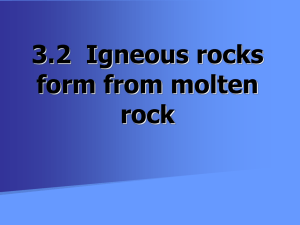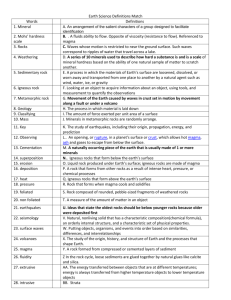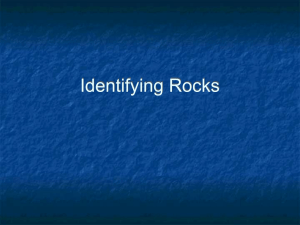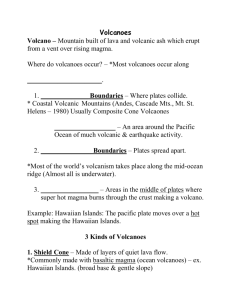3.2 Igneous Reading and Qs
advertisement
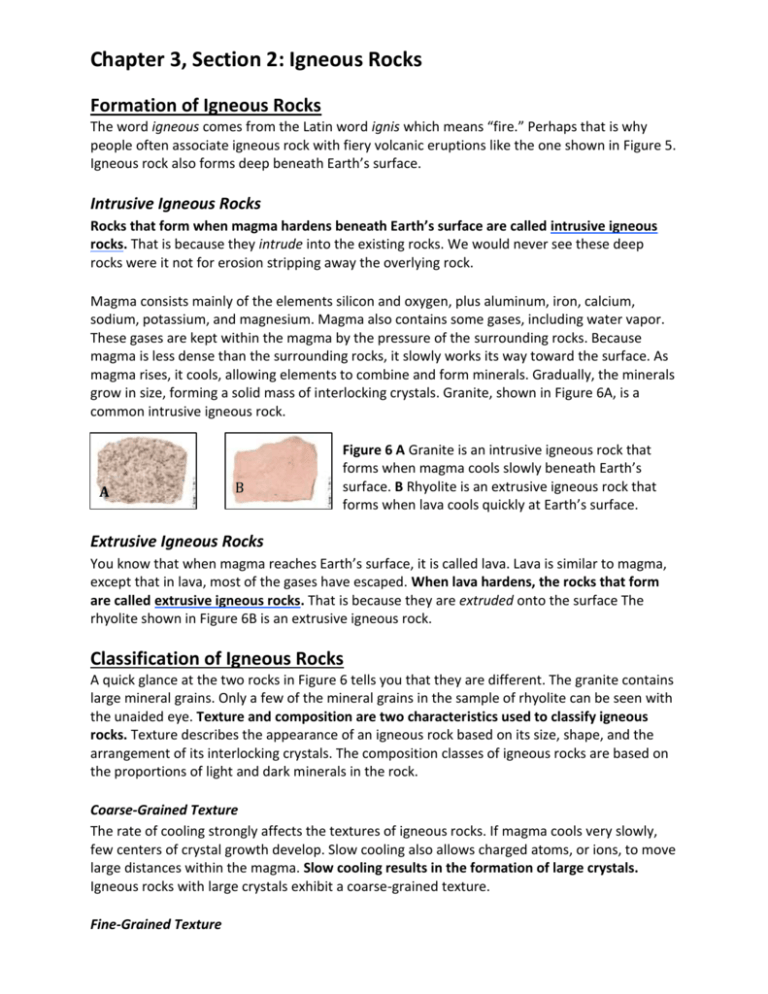
Chapter 3, Section 2: Igneous Rocks Formation of Igneous Rocks The word igneous comes from the Latin word ignis which means “fire.” Perhaps that is why people often associate igneous rock with fiery volcanic eruptions like the one shown in Figure 5. Igneous rock also forms deep beneath Earth’s surface. Intrusive Igneous Rocks Rocks that form when magma hardens beneath Earth’s surface are called intrusive igneous rocks. That is because they intrude into the existing rocks. We would never see these deep rocks were it not for erosion stripping away the overlying rock. Magma consists mainly of the elements silicon and oxygen, plus aluminum, iron, calcium, sodium, potassium, and magnesium. Magma also contains some gases, including water vapor. These gases are kept within the magma by the pressure of the surrounding rocks. Because magma is less dense than the surrounding rocks, it slowly works its way toward the surface. As magma rises, it cools, allowing elements to combine and form minerals. Gradually, the minerals grow in size, forming a solid mass of interlocking crystals. Granite, shown in Figure 6A, is a common intrusive igneous rock. A B Figure 6 A Granite is an intrusive igneous rock that forms when magma cools slowly beneath Earth’s surface. B Rhyolite is an extrusive igneous rock that forms when lava cools quickly at Earth’s surface. Extrusive Igneous Rocks You know that when magma reaches Earth’s surface, it is called lava. Lava is similar to magma, except that in lava, most of the gases have escaped. When lava hardens, the rocks that form are called extrusive igneous rocks. That is because they are extruded onto the surface The rhyolite shown in Figure 6B is an extrusive igneous rock. Classification of Igneous Rocks A quick glance at the two rocks in Figure 6 tells you that they are different. The granite contains large mineral grains. Only a few of the mineral grains in the sample of rhyolite can be seen with the unaided eye. Texture and composition are two characteristics used to classify igneous rocks. Texture describes the appearance of an igneous rock based on its size, shape, and the arrangement of its interlocking crystals. The composition classes of igneous rocks are based on the proportions of light and dark minerals in the rock. Coarse-Grained Texture The rate of cooling strongly affects the textures of igneous rocks. If magma cools very slowly, few centers of crystal growth develop. Slow cooling also allows charged atoms, or ions, to move large distances within the magma. Slow cooling results in the formation of large crystals. Igneous rocks with large crystals exhibit a coarse-grained texture. Fine-Grained Texture If cooling of magma or lava occurs rapidly, the ions in the melted material lose their motion and quickly combine. This results in a large number of tiny crystals that all compete for the available ions. Rapid cooling of magma or lava results in rocks with small, interconnected mineral grains. Igneous rocks with small grains are said to have a fine-grained texture. Glassy Texture When lava spews onto Earth’s surface, there may not be enough time for the ions in the lava to arrange themselves into a network of crystals. So the solids produced this way are made of randomly distributed ions. Such rocks have a glassy texture. The obsidian and pumice shown in Figure 1 on page 66 are igneous rocks with glassy textures. Porphyritic Texture A large body of magma located deep within Earth may take tens of thousands of years to harden. Minerals that crystallize from the magma do not form at the same rate or at the same time. It is possible for some crystals to become quite large before others even start to form. The resulting rock can have large crystals, called phenocrysts, surrounded by fine-grained minerals. Rocks with very different-size minerals experience different rates of cooling. These rocks have a porphyritic texture. The igneous rock shown in Figure 7 has a porphyritic texture. Figure 7 This sample of andesite displays igneous rock with a porphyritic texture. Describing Describe how this rock probably formed. Granitic Composition One group of igneous rocks includes those that are made almost entirely of the light-colored silicate minerals quartz and feldspar. Igneous rocks in which these are the main minerals are said to have a granitic composition. In addition to quartz and feldspar, most granitic rocks contain about 10 percent dark silicate minerals. These dark minerals are often biotite mica and amphibole. Granitic rocks contain about 70 percent silica and are the major rocks of the continental crust. Rhyolite is an extrusive granitic rock. Compare granite and rhyolite again in Figure 6 on page 71. Basaltic Composition Rocks that contain many dark silicate minerals and plagioclase feldspar have a basaltic composition. Basaltic rocks are rich in the elements magnesium and iron. Because of their iron content, basaltic rocks are typically darker and denser than granitic rocks. The most common basaltic rock is basalt, shown in Figure 8. Gabbro is an intrusive igneous rock with a basaltic composition. Figure 8 Basalt is an igneous rock made mostly of dark-colored silicate minerals. Describing Describe the texture of this igneous rock. Other Compositional Groups Rocks with a composition between granitic and basaltic rocks have an andesitic composition. This group of igneous rocks is named after the common volcanic rock andesite. Andesitic rocks contain at least 25 percent dark silicate minerals—mainly amphibole, pyroxene, and biotite mica. The other dominant mineral in andesitic rocks is plagioclase feldspar. Another important igneous rock is peridotite. This rock contains mostly the minerals olivine and pyroxene. Because peridotite is composed almost entirely of dark silicate minerals, its chemical composition is referred to as ultramafic. Although ultramafic rocks are rare at Earth’s surface, much of the upper mantle is thought to be made of peridotite. To summarize, igneous rocks form when magma or lava cools and hardens. Intrusive rocks form when magma cools and hardens deep within Earth. Extrusive rocks form when lava cools and hardens on Earth’s surface. Igneous rocks can be classified according to texture and composition. A general classification scheme based on texture and mineral composition is shown in Table 1. SECTION 3.2 Igneous Rocks Assessment Please answer all questions on lined paper and in complete sentences. Reviewing Concepts (1)Compare and contrast the formation of intrusive and extrusive igneous rocks. (2)How do coarse-grained igneous rocks form? (3)How are igneous rocks classified according to composition? (4)How do fine-grained igneous rocks form? (5)How do igneous rocks with glassy textures form? Critical Thinking (6) Contrasting Contrast basalt and granite in terms of how each forms, the texture of each rock, the color of each rock, and each rock’s composition. (7) Formulating Hypotheses The extrusive igneous rock pumice contains many small holes. Hypothesize how these holes might form.


